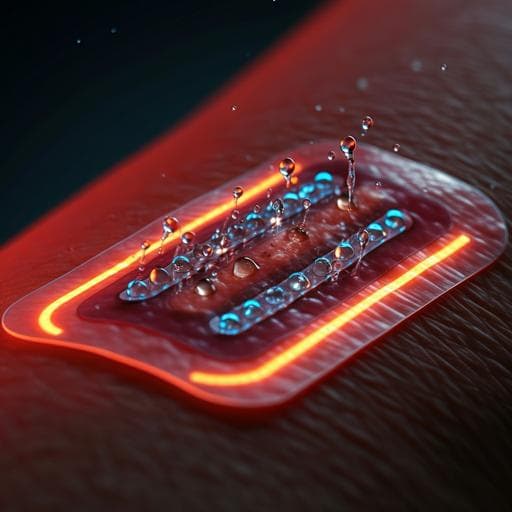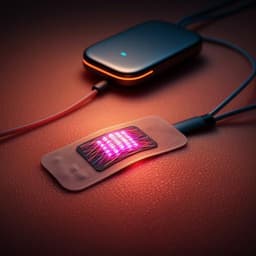
Engineering and Technology
An epifluidic electronic patch with spiking sweat clearance for event-driven perspiration monitoring
S. Kim, S. Park, et al.
Discover the groundbreaking research by Sangha Kim, Seongjin Park, Jina Choi, Wonseop Hwang, Sunho Kim, In-Suk Choi, Hyunjung Yi, and Rhokyun Kwak introducing an innovative epifluidic electronic patch designed for efficient, long-term perspiration monitoring. This patch utilizes a unique spiking sweat clearance mechanism, significantly enhancing data transmission while conserving energy, promising exciting implications for digital healthcare applications.
~3 min • Beginner • English
Introduction
Monitoring epidermal perspiration is important for fitness and medical applications, aiding hydration management and enabling early detection of acute conditions such as heart attacks and hypoglycemic shock. Chemical information in sweat correlates with blood composition, offering a non-invasive avenue for long-term health monitoring. However, current sweat-sensing platforms face two major challenges for long-duration use: (1) limited operating time due to finite sensor volume, which causes mixing of old and newly secreted sweat in collection channels or pads, and (2) high energy consumption and data storage demands from continuous, real-time wireless transmission, much of which is redundant. Increasing channel volume raises hydrodynamic resistance and reduces passive collection under natural perspiration pressure, while thermal flowmeters cannot simultaneously provide sweat rate and ionic conductivity in a single device. An event-driven scheme that transmits only essential information is desirable. Inspired by sensory neurons that encode stimulus intensity into spike frequency, the authors propose directly encoding perspiration dynamics into electronic spikes for event-driven, energy-efficient wireless monitoring. The study introduces an epifluidic patch that generates and processes spike patterns to decode sweat rate and ionic conductivity over long durations.
Literature Review
Prior approaches to extend operation time and improve sweat sensing include electrochemical measurements and microfluidic systems, but mixing of fresh and old sweat remains problematic when collection volumes fill. Scaling channel volume increases hydrodynamic resistance, impairing passive sweat capture under physiological pressures (~−3 kPa). A miniaturized thermal flowmeter can measure sweat rate over long periods with modest channels, but cannot simultaneously measure ionic conductivity in the same device. In data handling, continuous wireless monitoring consumes substantial power and yields redundant data. Event-driven, spike-based encoding inspired by neural systems offers energy efficiency and noise robustness; while neuron-inspired spike encoding has been demonstrated with additional sensors and circuitry, a platform that directly converts perspiration into spikes for event-driven, wireless monitoring had not been realized.
Methodology
Device design: A sweat VIA (vertical interconnect access)-type sensor with an open, truncated cone-shaped vertical channel collects sweat passively under natural perspiration pressure (<3 kPa). The channel features nanomesh electrodes (AgNW/CNT with electroplated Au) on the inner sidewall to measure electrical admittance, a super-hydrophilic CNT-coated PDMS sponge at the top to abruptly absorb and clear the channel, and a hydrophobic porous layer at the bottom to facilitate air ingress and cut liquid bridges for rapid clearance. Channel geometries tested had inlet radius ro = 0.75 mm, wall angle β = 116.7°, and heights ho = 0.35–1 mm with corresponding top outlet radii 0.625–0.25 mm. Hydrodynamic resistance for ho = 1 mm at 10 µL/min was ~−6.5 Pa, well below perspiration pressure.
Electrodes and sponge fabrication: Nanomesh electrodes were formed by hydrogel-templated transfer-printing: AgNWs and CNTs were spray-coated on an agarose hydrogel mold, PDMS was cured atop, and the cured PDMS carried the nanonetworks onto the channel wall; electrodes were electroplated with Au for biocompatibility and reduced low-frequency impedance. The sweat-clearing layer was a microporous PDMS sponge (sugar-templated, ~300 µm pores) treated with O2 plasma and coated with CNT networks for rapid wicking and high evaporation capacity. The sponge absorbed ~2.5 µL per mg and evaporated ~1.3 µL/min/cm² at 25.5 °C and 20% RH, exceeding typical skin sweat rates (10–1000 µL/h/cm²), supporting long-term operation.
Measurement principle: The equivalent circuit comprises two interfacial capacitors in series with sweat bulk resistance. Admittance is measured at frequencies above the characteristic 1/(2RC) so that resistive (conductive) components dominate; 50 kHz AC at 30 mV (bench tests) was used based on EIS showing resistive dominance above ~1 kHz. A spike cycle arises as the VIA fills (admittance rises), contacts the sponge (peak), and is cleared rapidly (admittance drops). Spike frequency encodes sweat rate (via known VIA volume), and peak admittance encodes ionic conductivity.
Benchtop characterization: Using an inverted fluorescence microscope and impedance analyzer, NaCl solutions (1–100 mM) were flowed to simulate sweat. Clearance occurred within ~3 s upon contacting the top sponge. Flow-rate tests: 0.1–10 µL/min; spikes observed up to ~7 µL/min; at 10 µL/min admittance stayed near peak (clearance insufficient to reset fully). Ionic conductivity tests: 2.4–92.7 mM NaCl (273–10,350 µS/cm) at 0.5 µL/min showed discrete peak admittance levels proportional to conductivity. Non-conductive sweat constituents (urea, serine, glycine) did not affect spike frequency or peak amplitude. Long-term tests explored the effect of sponge evaporation vs sweat rate on operation time; three devices ran 8 h at 0.5 µL/min showing reproducible spike periods.
Wireless platform and algorithm: A flexible PCB platform integrated the sweat VIA sensing module, BLE SoC, and power management. An AC excitation of 70 kHz, 30 mV was generated and a trans-impedance amplifier measured admittance; ADC data were transmitted via BLE and converted to admittance via calibration. An event-driven algorithm compared moving averages of old vs new data arrays; when their difference exceeded a clearance-derived threshold, only the spike data (peak information) were transmitted. Over 200 s, example traces showed 5 transmissions for event-driven vs 800 for continuous.
On-body study: Male participants wore two epifluidic patches on the chest (center C and right R); absorbent cotton pads on the left (L) provided manual reference samples replaced every 5 min. Participants cycled for 90 min at varying load levels followed by 10 min rest. Continuous and event-driven wireless readouts were collected; calibration curves converted admittance to sweat rate and conductivity. Total monitored sweat volume and cumulative evaporation capacity were compared to ensure long-duration feasibility.
Key Findings
- The sweat VIA sensor produces electronic spikes during perspiration via repeated filling and abrupt clearance of a vertical channel; spike frequency encodes sweat rate and peak amplitude encodes ionic conductivity.
- Dynamic range for flow encoding: clear spiking from 0.1 to ~7 µL/min; at 10 µL/min the channel remained near peak due to continuous filling. Spike frequency increased linearly with flow up to ~3 µL/min, then sublinearly as clearance time became non-negligible; a model including clearance time improved fit.
- Ionic conductivity encoding: peak admittance levels correlated with NaCl conductivity from 273 to 10,350 µS/cm (2.4–92.7 mM) at 0.5 µL/min; non-conductive analytes (urea, serine, glycine) did not affect spike metrics.
- Fast clearance: solution in the VIA cleared within ~3 s after contacting the CNT-PDMS sponge.
- Long-term operation: When sponge evaporation rate exceeded the sweat rate, operation continued for 24 h, monitoring ~720 µL total; when evaporation was lower, operation lasted ~7.6 h until sponge retained ~38% of absorption capacity. Three devices showed similar spike periods over 8 h at 0.5 µL/min, indicating reproducibility.
- Wireless efficiency: Event-driven transmission over 200 s required 5 data transfers consuming ~17.5 µJ vs 800 transfers and ~2798.4 µJ for continuous transmission, a reduction to ~0.63% of energy.
- On-body results: During a 100 min cycling protocol, spike frequency tracked load level (higher load → higher frequency). Event-driven decoding used ~0.57% (center C) and ~0.27% (right R) of the number of transmissions compared to continuous monitoring. The center chest patch produced spikes earlier than the outer patch, indicating spatial variation in sweat onset. Conductivity was high at exercise onset and decreased over time (dilution), with modest modulation by load. A single device electrically monitored >30 µL total sweat; estimated system capacity supports >24 h monitoring.
Discussion
The study addresses two central challenges in long-term sweat monitoring: limited sensing duration and high energy cost of wireless transmission. By engineering a low-resistance, truncated cone VIA channel with rapid, sponge-driven clearance, the device avoids mixing of old and new sweat, enabling effectively continuous operation independent of the small channel volume. Encoding perspiration dynamics into spike patterns allows extraction of essential information (rate via spike frequency and ionic conductivity via peak amplitude) while transmitting data only at events, drastically reducing wireless energy consumption without sacrificing key metrics. The wide dynamic range (0.1–7 µL/min) spans mild to heavy exercise; geometric tuning can shift this range as needed. On-body trials confirm that event-driven readouts capture physiological changes in sweat rate and conductivity across skin locations and varying loads, while requiring orders-of-magnitude fewer transmissions. Compared to thermal flow-based methods, this single device simultaneously measures rate and conductivity. The approach is robust to non-conductive sweat components and suitable for integration with other on-skin sensors and edge computing, suggesting broad relevance for energy-efficient, intelligent digital healthcare.
Conclusion
An epifluidic wireless patch incorporating a sweat VIA sensor with nanomesh electrodes and a super-hydrophilic CNT-PDMS sponge achieves event-driven, long-duration monitoring of epidermal perspiration. The platform directly encodes sweat rate and ionic conductivity into spike frequency and amplitude, enabling energy-efficient wireless transmission and accurate decoding of perspiration dynamics over hours to days. On-body studies demonstrated real-time tracking of sweat rate and conductivity during exercise with minimal data transmissions and the capacity to monitor large cumulative sweat volumes with a single device. Future directions include integrating additional biochemical and physical on-skin sensors, refining VIA geometry for tailored dynamic ranges, combining with edge/neuromorphic computing for on-device analytics, and extending monitoring to detect pre-symptoms of acute conditions such as nocturnal hypoglycemia and cardiac events.
Limitations
- Operation time depends on the balance between sponge evaporation and sweat rates; when evaporation is lower than sweat production, the device operated ~7.6 h until sponge retention approached ~38% of capacity, whereas higher evaporation enabled 24 h operation.
- At high flow (e.g., 10 µL/min), clearance could not fully reset the channel, suppressing distinct spikes; clearance speed becomes a limiting factor at upper-range sweat rates.
- Minor device-to-device variation exists, though three devices showed similar performance over 8 h at 0.5 µL/min.
- On-body comparisons with manually collected sweat showed small discrepancies in absolute values and timing, likely from manual collection errors and spatial variability of sweating.
- Performance may be influenced by environmental conditions (temperature, humidity) that affect evaporation; these were characterized in part but warrant further in-field validation.
Related Publications
Explore these studies to deepen your understanding of the subject.







